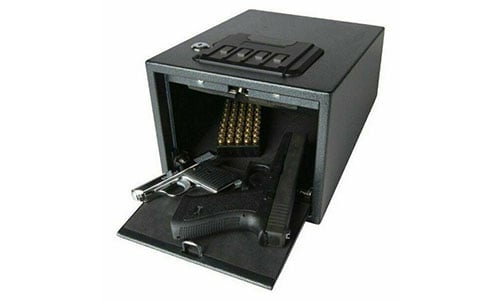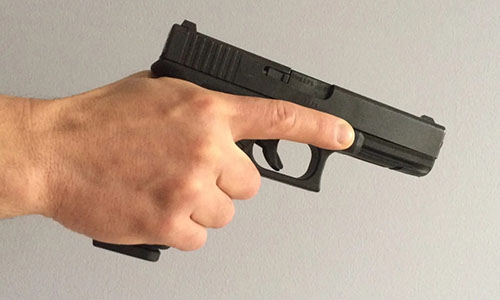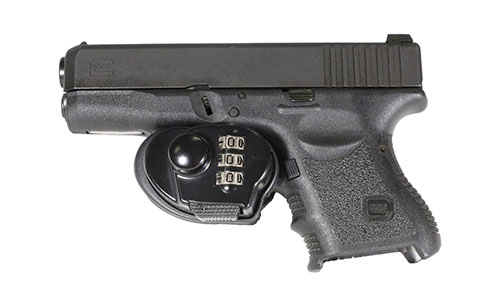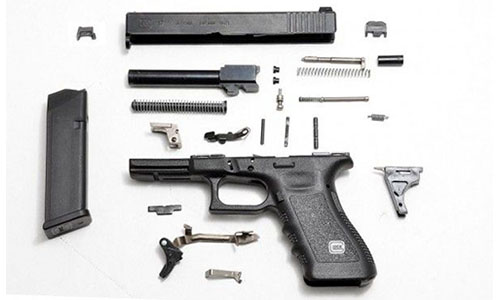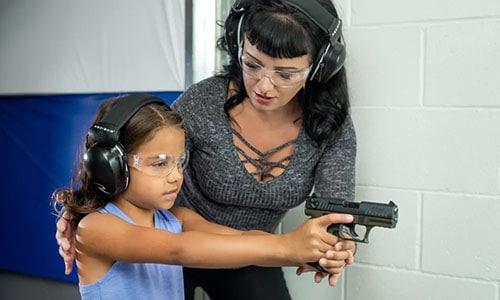Firearms are tools used for hunting, recreation and self defense. Like knives they are not toys. Failing to learn the right way to handle, store and maintain a firearm can, and all too often does, have disastrous consequences.
Keep in mind that gun safety is not just something that’s taught to novices and later forgotten. Any experienced gun owner worthy of their weapon will have internalized gun safety rules to the point that they are second nature and will practice them everywhere they go.
We’ve brought together the following list of 21 gun safety tips that should help novice or aspiring gun owners put their responsibilities in proper perspective, and allow veteran gun owners to brush up on some basic principles of gun safety should they feel it necessary.
1: Be Aware of the Gun Laws in Your State
Gun laws vary from state to state and even from year to year within a state. For instance, just within the past year Montana, Idaho, Utah and Wyoming have all passed laws allowing anyone with a legal right to own a handgun to engage in concealed carry without a permit. Because of this constantly shifting landscape, it is the responsibility of the gun owner to be up-to-date on the gun laws in their particular state.
Gun control has been a hot button topic since the 1960s when, following the assassinations of President Kennedy, his brother Senator Robert Kennedy and Martin Luther King Jr congress hastily passed the Gun Control Act of 1968 (1). Ever since then federal gun laws have shifted back and forth every few years and state laws have followed suit, typically in reaction to whichever way the federal gun law wind was blowing.
2: Always Wear Ear Protection
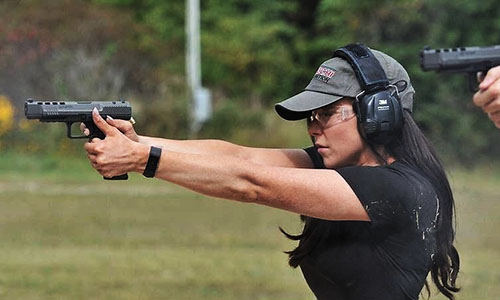
Any time you fire your gun at the range you need to be sure to wear ear protection. But not just any old earplugs will do. You need to make sure they are designed specifically for use with firearms. Movies and TV programs typically show people discharging firearms in close quarters without ear protection and being none the worse for wear. This is a total fantasy.
A 9mm pistol produces 159.8 dB, while a .357 Magnum produces 164.3 dB. When you compare those numbers with a jackhammer that produces 130dB, and you keep in mind that anything above 85 dB is considered dangerous for your hearing (2), you begin to understand why proper ear protection is so important.
3: Don’t Forget the Eye Protection
Most people understand the need to protect their hearing from gun noise, but are not so clear on why they need to wear goggles while at the range or hunting. Shooting goggles are more than just a fashion statement or an expression of someone’s gear fetish. They’re used to protect your eyes from a variety of very real hazards.
For instance, excessive powder from a round can blow back into your face when the gun is discharged. This powder can be hundreds of degrees and burn the soft tissue of the eye. In addition, goggles will protect your eyes against shells that are ejected from your firearm and will keep airborne debris from getting in your eye and affecting your vision.
4: Keep Your Gun Unloaded When Not In Use
One study that monitored gun-related injuries and deaths in the home in 2 American cities over the course of a year found that 54 out of 626 domestic shooting incidents were the result of accidental discharge (3). That is 8.6% of all domestic shooting incidents. In addition, more than 300 children gain access to guns and accidentally shoot themselves or others each year in the US.
Keeping your gun unloaded at all times when not in use is an absolute must. But that alone is not enough. You need to keep it in a secure location and you also need to keep ammo stored separately so that curious kids can’t put 1 and 1 together and produce tragedy.
5: Store Your Gun in a Safe Place
The overwhelming majority of gun owners are responsible, reliable individuals who use their firearms solely for sport or self defense. They understand that responsible ownership of firearms isn’t something that stops when they leave the range or when they return from the hunt. That responsibility extends to how they store their firearms once they get home.
Guns must always be kept out of the reach of children, visitors and all other unauthorized users. The gun or guns must also be stored unloaded with ammunition stored separately. Gun safes exist for both handguns and rifles, are readily available and are an excellent idea, particularly if there are children in the house. Failing to store your firearms safely could have catastrophic consequences.
6: Keep the Gun Safety On Unless Firing
Guns have safeties for a reason, to keep the gun owner and those he or she encounters safe from accidental discharge. The safety should be on at all times when you are not firing the weapon. Just keep in mind that safeties are no foolproof devices. While it’s not common, they have been known to fail with disastrous results.
The bottom line is to always keep the safety engaged when not using the gun. But even if it is engaged don’t dry-fire your weapon to impress someone just because you have the safety on and think nothing will happen. Safety or not, always assume the gun could go off unintentionally and treat it that way.
7: Always Point Your Gun in a Safe Direction
This is one of the foundational tenets of gun safety which, if followed by everyone, would eliminate most gun accidents. The basic rule is this: unless you are prepared to shoot it, don’t point your gun at it. This rule evolved early on in the history of guns and has been a bedrock principle ever since.
Accidental discharges happen all the time. Even when experienced professionals are present and no live ammunition is being used. Such was the case with actor Brandon Lee, son of martial arts legend Bruce Lee, who was accidentally shot and killed while filming the movie “The Crow” in 1993 (4). The bottom line: always be aware what direction your gun is pointing in, even if you are alone, and remember: if you are not prepared to destroy it, don’t point your gun at it.
8: Alway Keep Your Finger Off the Trigger Until You Need to Fire
Here’s another fundamental law of gun safety. Never put your finger on the trigger until you are ready to fire. Always keep your trigger finger extended straight out, resting safely on the side of the gun above the trigger mechanism. Do not drop it onto the trigger unless and until you are ready to shoot either at the target or in self defense.
This is just as important as keeping your gun unloaded and locked away when not in use, and not pointing your gun at anything you are not prepared to destroy. Countless injuries and worse have occurred because otherwise well meaning people have forgotten their finger was on the trigger and they accidentally discharged their gun.
9: Don’t Go Looking for Trouble
Tempting as it might be a gun is not an instrument of revenge, nor is it a way for a person to prove how tough or fearless they are. With that in mind it’s important that you not take any actions when you are carrying a gun that you would not take if you were unarmed.
For instance, don’t conceal a handgun under your coat and then wander into a neighborhood you would normally avoid. Or, take your gun with you to tell the neighbors to be quiet. If the neighbors are partying too loud, keep the gun in the safe and call the police. Also, don’t drive around with a loaded gun in the car. It’s just asking for trouble, and besides, it may be illegal depending on where you live (5).
10: Always Use the Appropriate Ammo for Each Gun
Every gun is made to accommodate a certain type of ammo and should only be used with that type of ammunition. In some cases the ammo a gun uses is stamped directly on the barrel. In other cases you may need to do 5 minutes of internet research to determine exactly what type of ammunition you should use with your particular firearm.
Whether you have a shotgun or a handgun using the wrong calibre ammunition can create a dangerous obstruction in the barrel that can lead to serious injury and/or damage to your gun. Because it’s possible for different types of ammo to fit into inappropriate weapons you need to always be sure that what you are loading into your gun belongs in your gun. If you have any doubt about whether you loaded the right ammunition, double check before firing.
11: Invest in a Trigger Lock
A trigger lock is a device, typically comprised of two pieces, that fits over the trigger and the trigger guard of a gun and is locked in place. As a result, even if the gun falls into the wrong hands the trigger cannot be accessed and the gun cannot be fired.
Some trigger locks use a key system, others use a combination lock system like you’ll find on a briefcase, and others have a digital locking mechanism. Some even use fingerprint recognition to open the lock. Though to be sure, that kind of system is going to cost a few dollars more than a key lock. But regardless of the price a trigger lock is an excellent way to prevent accidents.
12: Make Sure There is No Ammo In the Gun When Loading
Before you load your gun make sure to open the action and confirm that there is no ammo either in the chamber or the magazine. Also, make sure there are no obstructions in the barrel. Having a round in the chamber when reloading could result in injury or worse if the trigger is accidentally engaged while loading.
As for why you check the barrel… it only takes a minimal obstruction in a rifle barrel, such as a bit of mud or grease, to raise the internal pressure during firing. That extra pressure could cause a bulge in the barrel, or it could even cause the barrel to burst during firing. The results of a burst barrel are not pretty.
13: Keep Your Gun Clean and Well-Maintained
A gun is a tool, and just like every other tool it needs to be properly maintained or it won’t be there for you when you need it. That means, if you are using your gun on a regular basis you need to clean it on a regular basis. Because a gun is a precision instrument it does not take much to cause what could be a devastating malfunction.
But cleaning is not only necessary if you go to the range every weekend. If you haven’t used your gun in some time you will need to clean it before you use it. Moisture and dirt that have accumulated while it sat idle could cause performance problems. Likewise, grease and oil have a tendency to solidify if they sit long enough and that could also prevent the gun from firing properly.
14: Get to Know Your Gun Inside and Out
The more you know about your gun – how it’s put together and how it works – the better gun owner you will be. The best way to get to know your gun is to take it apart during the aforementioned cleaning. The owner’s manual that came with the gun should tell you how to do that.
If you bought the gun from a previous owner who lost the manual, there are numerous websites dedicated to the topic, as well as a number of books that have been published detailing how to assemble and disassemble various types of older guns.
15: Resist the Urge to Modify Your Gun
Modern rifles and pistols are the result of centuries of constant refinement. They’re fine just the way they are. If a particular rifle or handgun does not live up to your idea of what you want in a firearm, don’t alter it, try a different gun. There are hundreds of models on the market these days. Each one has been expertly designed and has its own characteristics. If you shop around a bit you’re sure to find one that’s to your liking.
Attempting to modify your gun yourself could lead to safety and performance issues, and could put you in very hot water with John Law should you ever be involved in a situation that prompted police intervention. If you really like the idea of tinkering with firearms, get yourself an AR-15. They are one of, if not the most, modular firearms ever invented. You can mix and match components and add accessories to your heart’s content and wind up with an outstanding, reliable weapon that speaks to your sensibilities and tastes.
16: Keep All Firearms Away From Children
This is a no-brainer and something we have mentioned in passing several times already, but it bears repeating. Young kids are curious types. Everything is new to them so they’ll grab or touch anything they can get their hands on, including guns. At some point when they’re capable of understanding you’ll teach them about gun safety, but until then you have to be scrupulous about keeping any and all guns safely secured where they can’t get at them.
Some say that if you have young kids you should never keep a gun in the house. Nonsense. You just need to be responsible. Leaving the car running in the garage could cause carbon monoxide to leak into the house and kill everyone. But you’re responsible so you don’t do that. You also don’t leave sharp knives lying around on the kitchen table or buy the kids toys they could choke on. Same with your gun. Act responsibly. Keep it locked away where the kids can’t get it.
17: Don’t Use Your Gun Like a Firecracker
In some countries firing into the air every time something noteworthy happens is common. Common, and stupid. What goes up must come down as Newton demonstrated several hundred years ago, and yet people seem to forget this basic law of physics.
A bullet fired straight up in the air can reach a height of 10,000 feet or more before turning and plummeting to earth. On the way down it will lose most of its velocity but will still be dangerous enough to cause serious injury and even death (6)(7). The risk of injury or death is even more pronounced if the bullet is fired at an angle instead of straight up. If you want to celebrate, throw a party.
18: Only Use Your Gun When Sober
This should be another no-brainer but it’s surprising how many people reach for their firearm when they’re 3 sheets to the wind. At the very least, alcohol is going to impair your judgement and, for some people, increase the risk of confrontations. If you don’t drive drunk, (and let’s hope you don’t), then you shouldn’t be holding or carrying a firearm when drunk or drinking.
If you plan to go out for a night on the town with your buddies don’t engage in concealed carry. There is nothing good that can come of it. If you feel like you need to have a firearm on you because of the reputation of a certain bar or club, or because of the location of that establishment, you’re better off just avoiding the place altogether.
19: Don’t Load Your Gun Indoors
Inside the house – or for that matter inside a car, RV or tent – there is usually no safe direction to point a gun in. Since not having a safe direction in which to point the gun violates our earlier rule (“Always point your gun in a safe direction”) take your gun outdoors to load it whenever possible.
There are exceptions to every rule, but in general the only time it’s acceptable to load a firearm indoors is if you are in the military or a member of law enforcement and you are under siege, or you are at an indoor firing range specifically designed for the use of firearms.
20: Teach Your Family About Gun Safety
If you have a family and purchase a firearm don’t hide the gun away and never speak of it. Instead, take the time to teach everyone who is old enough about gun safety. This will help ensure that, whether or not the kids grow up to be gun owners, they’ll at least have a realistic idea of the dangers and benefits of guns and how to handle them safely.
When talking to kids about guns it’s important to stress that guns are not toys, and that, while some people misuse them to cause harm, 99% of gun owners are responsible individuals. Teaching family members about the right way to handle guns is just as important as teaching your kids the right way to operate a motor vehicle. Once they know, the odds of an accident are greatly reduced.
21: Don’t Shoot Blindly Into the Distance
The rule is pretty self-explanatory. If you can’t see what you’re shooting at, don’t shoot. If you suspect someone is in your house or on your property but you can’t see them, hold your fire. What you hear might be a dog or a family member simply rummaging around in the house late at night (8).
Even if you don’t shoot your dog or child the bullet is going to go somewhere. It might go through the wall of a neighbor’s house, or it might strike someone a mile away who was just minding their own business. Remember, even a .22 bullet can travel more than 2 1/2 miles at high velocity. Also, if you are tempted to fire a warning shot into the air to scare off any potential ne’er-do-wells, keep in mind that, as we mentioned above, that bullet is going to come down somewhere, possibly injuring or even killing an innocent 3rd party.
